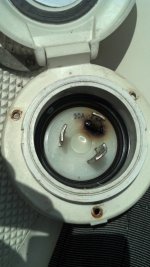I remember reading Jim's post this summer about having an arcing even at his shore power connection and how he replaced his Marinco plug with a Smart Plug. At the time, I thought, I should probably do the same prior to the arc. But then I looked at the price and thought hey, I got 7-ish years out that connector on my old boat and the current boat is newer, it can wait. Well.....
I went out to the boat yesterday to do some other wiring work and discovered there was no power on the boat. The plug was lit up so I knew I had power to the boat but it wasn't making it to the panel (which had a reverse polarity indicator lit). So I disconnected the breakers and took the shore power cord out the connector at the boat. It was tough to remove and lo and behold, I see this.

There was a corresponding burn on the cord side and the wiring on the inside was toasted about 1-2" back also. So needless to say, I now have a new Smart Plug installed. I still have to find the time to clean all the wiring back (cable ties etc.) but I've got power back to the boat and the charger was doing it's job again. Unfortunately, we got one complete discharge of the house battery as I had left the airhead fan on and also had the parasitic drain of the stereo.
I went out to the boat yesterday to do some other wiring work and discovered there was no power on the boat. The plug was lit up so I knew I had power to the boat but it wasn't making it to the panel (which had a reverse polarity indicator lit). So I disconnected the breakers and took the shore power cord out the connector at the boat. It was tough to remove and lo and behold, I see this.

There was a corresponding burn on the cord side and the wiring on the inside was toasted about 1-2" back also. So needless to say, I now have a new Smart Plug installed. I still have to find the time to clean all the wiring back (cable ties etc.) but I've got power back to the boat and the charger was doing it's job again. Unfortunately, we got one complete discharge of the house battery as I had left the airhead fan on and also had the parasitic drain of the stereo.
